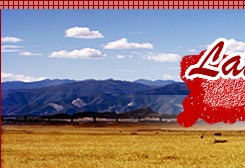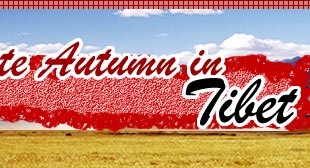|
Late Autumn in Tibet
The azure sky and white clouds over Gonggar Airport
in Lhasa look as if they came straight from a travel ad for Tibet,
almost unbelievable in the vibrant intensity of their colors.
The scenery and customs of Tibet vary widely, depending on the
season and the locale. But at any time, in any area, visitors
are bound to be enchanted by the pure air, astonishing beauty
and rich traditional culture.
This album features the people and places of Lhasa, Xigaze and
Nyingchi in late autumn. The photographs were selected from more
than 1,000 that were taken over a 20-day period in autumn 2004.
Lhasa
Lhasa is a city where modernity mingles with tradition and the
material world fuses with the spiritual.
A 70-year-old grandmother in traditional Tibetan garb leads a
boy of six to the Jokhang Monastery. Dropping the aromatic leaves
they carry into a huge incense burner, they watch the auspicious
smoke drift upward. Then the grandmother closes her eyes and puts
her palms together in prayer, while the small boy imitates her.
Secular pursuits flourish right alongside those of the spirit.
Not far from the monastery is the Barkhor Bazaar, where visitors
from around the world bargain with shopkeepers in a variety of
languages and gestures, seeking the best price for Tibetan-style
arts and crafts.
At an elevation of 3,657 meters, Lhasa is located on the northern
bank of the Lhasa River, a tributary of the great Yarlung Zangbo.
It is the capital and biggest city of the Tibet Autonomous Region,
and also its political, economic, cultural and transportation
center. Lhasa has a population of 400,000 made up of more than
30 ethnic groups, including Tibetan, Han and Hui.
The 1,300-year-old city is also the region's religious center.
In Tibetan, the word "Lhasa" means "holy land."
It is the traditional residence of the Dalai Lama, one of Tibet's
two top religious leaders, and thus several architectural treasures
are situated there: Potala Palace, Jokhang Monastery, Drepung
Monastery, Sera Monastery, Gandain Monastery and Norbulingka.
Travelers who come to marvel at the ancient monasteries and imposing
palaces can also enjoy the comforts of well-appointed hotels,
restaurants offering diverse cuisines and stores of all sorts
and sizes where an array of goods ranging from the humble to the
luxurious is available. Private automobiles, taxis and bicycles
run side by side on the roads, offering numerous options for the
footsore.
Despite the contrasts, some images of Lhasa are timeless and
endless. Butter lamps burn in the temples all year round and an
endless stream of faithful pilgrims flows toward the Barkhor.
Men and women, young and old, don their traditional Tibetan clothing
whether for work, play or to shake their sutra canisters as they
circle Jokhang Monastery.
Monk Nyima Cering lives in a tidy, simple cell at Jokhang Monastery.
On his desk is a computer, which has become an important tool
for his research and data storage. He is also an excellent amateur
photographer, often recording scenes at the monastery: people
worshipping and special religious rituals. His fluent English
and easily understandable explanations of Buddhism make him an
excellent tour guide. Busy Nyima Cering is also the deputy director
of the Jokhang Monastery Management Committee, a member of the
All-China Youth Federation, a deputy to the People's Congress
of Tibet Autonomous Region and a permanent member of China Buddhism
Association, Tibet Branch.
Xigaze
At the Parlha Manor of Gyangze County, the social and economic
gulf that divided the landed gentry from the serfs of old Tibet
is immediately apparent.
The Parlha Manor is the best-preserved landholding of the aristocracy
in the region. Fifty-seven buildings now stand on the grounds,
including the three-story main house. The owners' home comprises
a sutra chanting hall, studies and bedrooms as well as a special
hall for playing mahjong. The beams and ridgepoles are all delicately
carved, the workmanship magnificent.
In contrast, 13 rooms for serfs are narrow, low and dark, reminiscent
of prison cells. In fact, the old disciplinary barracks, complete
with scourge and shackles, still stand on the grounds.
At the time Tibet began its democratic reform about half a century
ago, the Parlha fiefdom included 22 subordinate manors, six pastures,
570 hectares of farmland, 14,250 head of livestock and 2,440 serfs.
A local resident, his face deeply creased with age, still recalls
his youth as a serf. But he prefers to talk about today: he got
a good price for his vegetables this past summer and is looking
forward to the autumn harvest.
Xigaze Prefecture is an important agricultural area. In recent
years, each county has specialized in different crops, and the
vegetables and grains grown in the area have a good reputation
throughout Tibet. In late autumn, the highland barley is ripening
and the farmers hard at work in their fields create a colorful
portrait set in gold.
Gyangze's Dzong Hill is a monument to the people's resistance
against foreign invasion and maintenance of national unity. In
1903 British colonialists dispatched troops to Tibet, and the
soldiers occupied Gyangze in April 1904. The army and people of
Gyangze, armed with simple broadswords, long spears and stones,
defended the ancient castle at Dzong Hill, the seat of the local
government. They held out for two months against British soldiers
who were equipped with modern guns and cannons. But at the end
of the long siege, food and other supplies exhausted, the defenders
jumped from the cliff. The walls of the ancient castle still bear
the scars of the cannon fire and traces of bullets.
Xigaze City is the administrative hub of Xigaze Prefecture, and
it is also Tibet's second largest city. The home of the Panchen
Lama, the city is also a religious center. At the famous Tashilhunpo
Monastery, the young Panchen Lama himself presides over solemn
ceremonies featuring ritual dances.
Nyingchi
Bayi Town is the seat of the Nyingchi prefectural government,
but when a gentle rain stops and a rainbow spans the fields, it
can more closely resemble a fairyland.
Nyingchi, in the eastern part of the region, is often referred
to as the Emerald of Tibet. With an average elevation of 3,000
meters, the prefecture has a humid climate and lush vegetation.
In the valleys, plant growth appears in layers, divided by altitude.
Snow-capped mountains, forests, grasslands, lakes and rivers abound,
creating a multitude of scenic spots.
Basum Co Lake, not far from Nyingchi, is a holy lake of the Tibetan
people. Seen from above, it is a crescent laid within the high
valleys. In late autumn, the sky is blue and the maple leaves
flame with color. Sand birds and white cranes soar above the lake,
which mirrors the surrounding mountains. In its center is an island
on which the Co Zonggongba Monastery was built during the Tang
Dynasty (618–907). It is a famous monastery of the Nyingma (Red)
Sect of Tibetan Buddhism, with disciples constantly coming and
going.
Many travelers make Nyingchi their first stop in Tibet, not only
because of its beauty but also because of its relatively low altitude:
lowland dwellers have an easier time acclimating there and moving
gradually to the higher country. Although visitors have to take
a bus to get to Nyingchi at present, within three years the new
Nyingchi Airport will be opened. It will be Tibet's third civil-use
airport, joining Gonggar in Lhasa and Bangda in Qamdo.
People who have been to Tibet say that one visit is not enough
– in fact, even a thousand visits may not be enough. At the end
of every trip, they begin planning the next, knowing that they
will yearn to return to this beauty.
(China.org.cn December 17, 2004)
|





